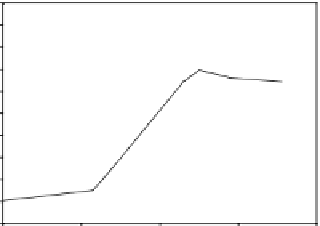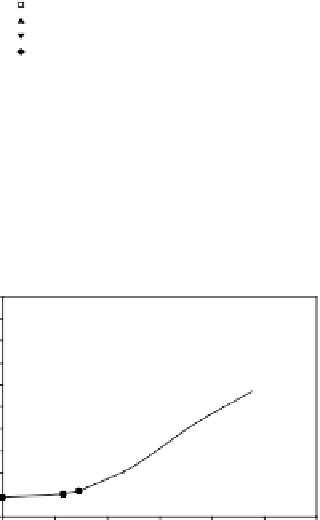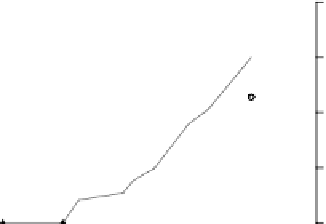Environmental Engineering Reference
In-Depth Information
Growth of LB400 (pRT1) on Mix C (1 mM)
0.50
1.7
Growth on 1 mM Mix C
Cl
−
, mM
2CBA, mM
4CBA, mM
2, 4CBA, mM
1.6
0.45
1.5
0.40
1.4
1.3
0.35
1.2
1.1
0.30
1.0
0.9
0.25
0.8
0.20
0.7
0.6
0.15
0.5
0.4
0.10
0.3
0.2
0.05
0.1
0.00
0.0
0
20
40
60
80
Time, hours
Growth of LB400 (pRO41) on Mix C (1 mM)
0.50
2.0
Col 7 vs Col 8
Col 7 vs Col 9
Col 7 vs Col 10
Col 7 vs Col 11
Col 7 vs Col 12
0.45
0.40
1.5
0.35
0.30
0.25
1.0
0.20
0.15
0.5
0.10
0.05
0.00
0.0
0
20
40
60
80
100
120
Time, hours
Figure 6.17
Growth of LB400(pRO41::
ohb
) and LB400 on mix C.
more active and PCB tolerant gram-negative
Burkholderia xenovorans
LB400(pRO41::
ohb
), is the most effective for achieving maximum PCB
degradation.
Sediment samples were obtained from the Red Cedar River (Michigan)
and contaminated with Aroclor 1242. The sediment was inoculated with
anaerobic-dechlorinating microorganisms eluted from the River Raisin
(Michigan) sediment and submitted to anaerobic conditions for 1 year. The
anaerobic treatment was followed by inoculation with the aerobic GEMs,
rifampicin-resistant recombinants RHA1(
fcb
) and LB400(
ohb
). The aerobic
inoculums were grown on 3 m
M
(nominal concentration) medium contain-
ing BP and 2,5-CBA, respectively. Cells were added to 1 g of contaminated
sediment (50% solids microreactors) to give a density of 10
4
(low-density
treatment) or 10
6
(high-density treatment) cells g
-1
of sediment for each
recombinant strain. Noncontaminated sediment as well as noninoculated
contaminated sediment submitted to the same conditions were used as con-
trols. Flasks were continually shaken at 150 rpm and incubated in duplicates
at 30˚C for 30 days. Sediment samples were stored at -20˚ for soil DNA and
PCB extractions. Samples were taken periodically and immediately diluted.
Population dynamics of recombinant RHA1(
fcb
) and LB400(
ohb
) strains were






































































